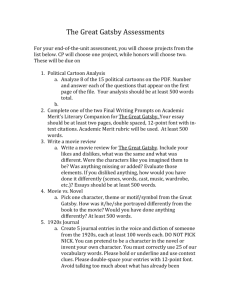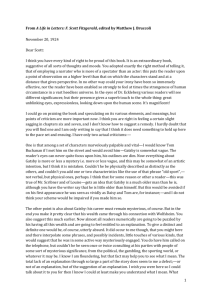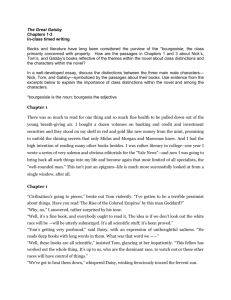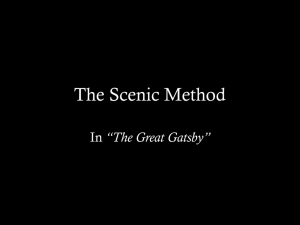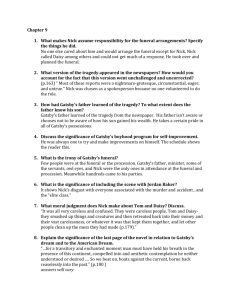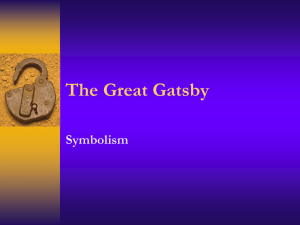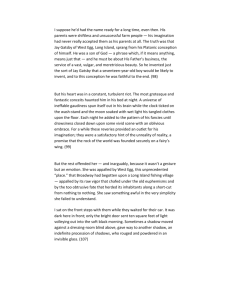Gatsby Questions
advertisement
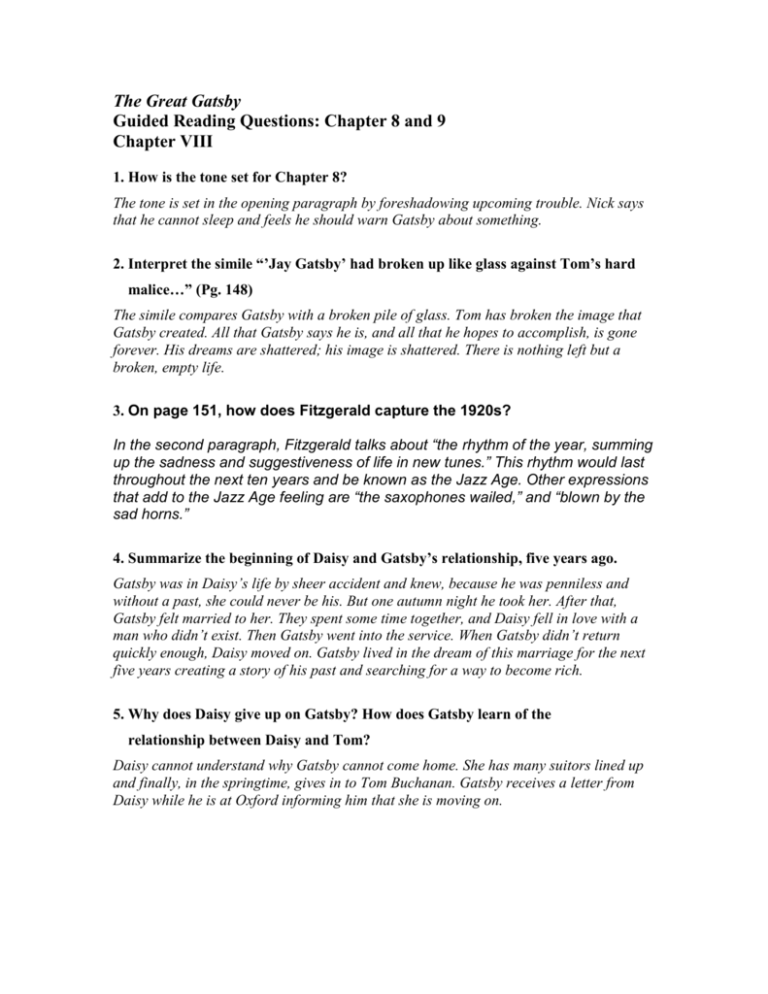
The Great Gatsby Guided Reading Questions: Chapter 8 and 9 Chapter VIII 1. How is the tone set for Chapter 8? The tone is set in the opening paragraph by foreshadowing upcoming trouble. Nick says that he cannot sleep and feels he should warn Gatsby about something. 2. Interpret the simile “’Jay Gatsby’ had broken up like glass against Tom’s hard malice…” (Pg. 148) The simile compares Gatsby with a broken pile of glass. Tom has broken the image that Gatsby created. All that Gatsby says he is, and all that he hopes to accomplish, is gone forever. His dreams are shattered; his image is shattered. There is nothing left but a broken, empty life. 3. On page 151, how does Fitzgerald capture the 1920s? In the second paragraph, Fitzgerald talks about “the rhythm of the year, summing up the sadness and suggestiveness of life in new tunes.” This rhythm would last throughout the next ten years and be known as the Jazz Age. Other expressions that add to the Jazz Age feeling are “the saxophones wailed,” and “blown by the sad horns.” 4. Summarize the beginning of Daisy and Gatsby’s relationship, five years ago. Gatsby was in Daisy’s life by sheer accident and knew, because he was penniless and without a past, she could never be his. But one autumn night he took her. After that, Gatsby felt married to her. They spent some time together, and Daisy fell in love with a man who didn’t exist. Then Gatsby went into the service. When Gatsby didn’t return quickly enough, Daisy moved on. Gatsby lived in the dream of this marriage for the next five years creating a story of his past and searching for a way to become rich. 5. Why does Daisy give up on Gatsby? How does Gatsby learn of the relationship between Daisy and Tom? Daisy cannot understand why Gatsby cannot come home. She has many suitors lined up and finally, in the springtime, gives in to Tom Buchanan. Gatsby receives a letter from Daisy while he is at Oxford informing him that she is moving on. 6. In what ways can the letter from Daisy be considered Gatsby’s salvation? The person with whom Daisy was in love did not exist. If Gatsby had returned, the fact that he had no money and no past would surely come out. This letter got him off the hook for the present. 7. After all that has taken place, how does Nick say he feels about Gatsby? What does he mean? Is he sincere? Nick says, “You’re [Gatsby] worth the whole damn bunch put together.” (Pg. 154) Although at first glance this sounds like a compliment, in actuality Nick is saying that even though he knows Gatsby isn’t the greatest, in comparison to the crowd, Gatsby looks angelic. Following this statement to Gatsby, Nick informs the reader that he is glad he said that to Gatsby although “I disapproved of him from beginning to end.” (Pg. 154) 8. In general, what is Nick’s attitude toward Gatsby? Nick’s attitude toward Gatsby is often times ambivalent and even contradictory. On the one hand, Nick romanticizes and admires Gatsby, describing the events of the novel in nostalgic, mournful tones, and, on the other hand, he seems to disapprove of Gatsby’s excesses and breaches of manners and ethics. 9. What does Jordan do the morning following the accident? She leaves Daisy’s house and gives Nick a call. After a rather curt conversation, one of them just hangs up. 10. What clues give Wilson the idea there is another man? His wife came home from the city some months earlier with her face bruised and her nose swollen. Secondly, Wilson discovered an expensive dog leash in her drawer. 11. What conclusion does Wilson come to regarding his wife’s death? He concludes she was hit by the driver of the yellow car. She ran to speak to him, but he did not stop. 12. Who does Wilson associate with the yellow car? Since Tom, claiming ownership of the yellow car, stopped by the garage earlier, it seems that Wilson will assume the driver is Tom. Wilson also notes that she ran to speak to him; in other words, she must have known him. Wilson knows that Tom and she are acquainted. 13. Where does Wilson spend the day following Myrtle’s death? Wilson spends the day wandering around from Port Roosevelt to Gad’s Hill. By half past two, he is in West Egg, looking for Gatsby. 14. Where do you think Wilson gets the information to track the car to Gatsby? Use evidence from the text. Wilson spends the day wandering around from Port Roosevelt to Gad’s Hill. By half past two, he is in West Egg, looking for Gatsby. 15. Analyze the technique that Fitzgerald uses in the third paragraph, on page 161, to indicate that Gatsby is no longer living in a dream and to foreshadow who his killer may be . The paragraph starts with the idea that an expected phone call never comes. Gatsby realizes that the phone call [from Daisy] he has waited for is not coming either. He has for so long followed a single dream, that it is almost as if he were living under a cloud. Now that cloud is gone. He looks up and sees how frightening the leaves are, how grotesque a rose is, and how raw the sunlight is. Gatsby, for the fi rst time in fi ve years, sees the real world. One of the things he sees, as he fl oats about on his raft, is an ashen figure gliding toward him—ashen because he comes from the valley of ashes: Wilson. 16. How is Gatsby’s body discovered? Nick arrives at Gatsby’s house late in the day and rushes anxiously up the steps. The four people in the house—the butler, the chauffer, a gardener, and Nick— run to the pool. There lies Gatsby, on the mattress, dead. 17. Why does no one find Gatsby earlier? The reader cannot discern why Gatsby is not found earlier. But, because Nick says that he believes they [the butler, chauffer, and gardener] knew earlier, the reader believes they knew earlier also. The chauffeur confesses to hearing shots fi red and simply says he “hadn’t thought anything much about them,” a good indication that perhaps he is covering something up. (Pg. 161) 18. What do you suspect happened to Wilson? One answer may be that Wilson turns the gun on himself after seeing what he has done. Another possibility is that the gardener, or one of the others, kills Wilson after hearing the shots and running out to help. Since Gatsby’s workers are all associated with Wolfsheim, and none of them confess to finding Gatsby before Nick arrives, it seems that one of them may have something to hide. And yet another possibility is that Wilson, like President Wilson, has a stroke. Chapter IX 1. How does Catherine respond during the trial? Catherine shows amazing strength of character. She swears her sister has never seen Gatsby and is a faithful wife to George. Perhaps in her mind, it is true regarding Gatsby. However, Catherine does know of Myrtle’s affair with Tom. 2. Why is it important to Catherine that her story seem true? Catherine does not want her, or her sister’s name, tarnished. Catherine also has no esteem for Mr. Wilson and does not mind that this murder makes him seem crazy. 3. When it is time for the funeral, what becomes of Gatsby’s friends? Nick proves to be a good friend and is there to help Gatsby’s father with arrangements. Tom and Daisy skip town. Wolfsheim is tied up with business. The postman and four or five servants show up at the house. Owl Eyes shows up late, at the graveside. All those who frequented his parties are nowhere to be found. 4. Describe Gatsby’s father. Gatsby’s father is Henry C. Gatz from Minnesota. He is a solemn old man with a sparse graybeard. 6. What irony is found in the top paragraph on page 170? 7. Where is Gatsby buried? Gatsby is buried in the East. 8. What is Nick’s fantastic dream? How does Nick view the East? Nick’s dream is about four solemn men in dress suits who are carrying a drunken woman on a stretcher. They go into the wrong house. “But no one knows the woman’s name, and no one cares.” (Pg. 176) At this point, Nick views the East as a cold, heartless place. 9. What becomes of Jordan and Nick’s relationship? Before Nick leaves the East, he meets Jordan to talk with her. She announces she is engaged to someone else. She accuses him of dumping her on the phone. Nick walks away, angry, half in love, and tremendously sorry. 10. Explain the analogy on page 177 comparing drivers with relationships. Jordan compares herself with a bad driver. It is all right to be a bad driver until you meet another bad driver [Nick]. When a car with a good driver meets a car with a bad driver, accidents can be prevented since the good driver will compensate for the mistakes of the bad driver. In relationships, weaknesses can be compensated for as well, unless both partners have the same weakness. Her accusations are that Nick is neither honest nor straightforward. The irony in her accusations is that she is neither honest nor straightforward, that is the downfall of their relationship. 11. When does Nick head west? It is Christmas time when Nick leaves the East. 12. Describe Nick and Tom’s final meeting. Nick sees Tom in October, on Fifth Avenue, in front of a jewelry store. Nick stops Tom and confronts him regarding the day Wilson killed Gatsby. He knew then that it was Tom who told Wilson that Gatsby had killed Myrtle. Nick sees that Tom and Daisy are reckless people who think only of themselves; careless people who smash things up and then retreat back into their money. 13. Summarize the final message of the epilogue. 14. From what viewpoint is The Great Gatsby told? The Great Gatsby is narrated by Nick in both fi rst and third person, presenting only what he observes. At times, Nick presents events objectively, as they appear to him at the time. Alternately, he steps out of the story and gives his interpretation of the story’s meaning andthe motives of the characters. 15. What events constitute the rising action, climax, and falling action? The rising action takes place in the fi rst four chapters and includes the descriptions of both Buchanan’s and Gatsby’s homes, and the lavish parties. The climax could be Gatsby’s reunion with Daisy in chapters V and VI or Gatsby and Tom’s meeting in the hotel. The falling action is Daisy’s rejection of Gatsby, Myrtle’s death, and Gatsby’s murder.


